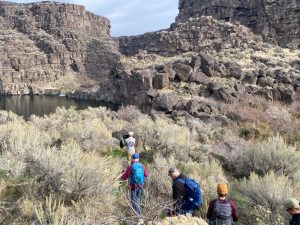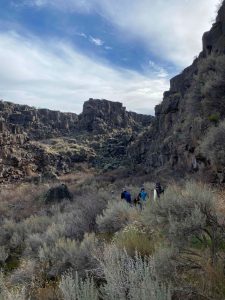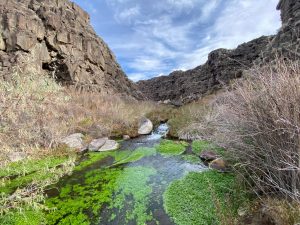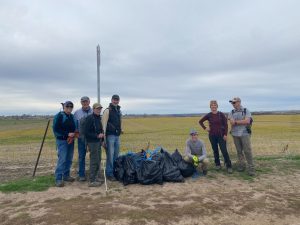Returning to Vineyard Lake: a hands-on approach to cleaning up around the Snake River
In the summer of 2022, Idaho Conservation League members, volunteers, and staff ventured to Vineyard Lake to pick up trash and learn about the state of the Snake River. This November, staff, members, and volunteers returned to this spectacular pocket of the Snake River Canyon to continue where we’d left off in 2022.Vineyard Lake is nestled within the dark black walls of a 2-million-year-old basalt and is a true hidden treasure of the Snake River Canyon. It was carved out by the great Bonneville Flood nearly 14,500 years ago, when an enormous Ice Age lake in the area of present Great Salt Lake in Utah released a massive flow of water into the Snake River watershed, flowing the same course as the Snake follows today. Flood waters east of Twin Falls were rerouted north of the Snake River Canyon, leaving a trail of scoured basalt behind. This stretch of basalt is still dotted with remnants of flood waters, housing natural beauties like Vineyard Lake, Devils Corral, Shoshone Falls, and Twin Falls. Despite being somewhat isolated, Vineyard Lake still sees high numbers of visitors, especially in warmer months—and the land is feeling the impact. Unfortunately, trash often speckles the landscape. As Idaho continues to see an influx in population and visitors, recreating responsibly is more important than ever.To help take care of this special place, ICL hosted the first Vineyard Lake Cleanup in June of 2022, clearing around 150 pounds of trash. Amazed by the impact we were able to produce in only a few short hours, ICL decided to return a little over a year later to replicate the effort.Last Saturday, ICL staff and six enthusiastic volunteers set off with protective gloves and garbage bags, eager to make a meaningful difference at Vineyard Lake. We convened on a dirt road in Eden, Idaho, and briefly trekked through private farmland—on which passage to the lake is graciously permitted—before beginning our descent into the canyon.
Despite being somewhat isolated, Vineyard Lake still sees high numbers of visitors, especially in warmer months—and the land is feeling the impact. Unfortunately, trash often speckles the landscape. As Idaho continues to see an influx in population and visitors, recreating responsibly is more important than ever.To help take care of this special place, ICL hosted the first Vineyard Lake Cleanup in June of 2022, clearing around 150 pounds of trash. Amazed by the impact we were able to produce in only a few short hours, ICL decided to return a little over a year later to replicate the effort.Last Saturday, ICL staff and six enthusiastic volunteers set off with protective gloves and garbage bags, eager to make a meaningful difference at Vineyard Lake. We convened on a dirt road in Eden, Idaho, and briefly trekked through private farmland—on which passage to the lake is graciously permitted—before beginning our descent into the canyon.  Under a warm, mid-morning sun, we wove our way through basalt boulders. Joined by volunteers who are also members of Prairie Falcon Audubon, we called out birdlife we spotted on our way down the trail. Flitting canyon wrens, some red-tailed hawks, and chattering kingfishers stole our attention and reminded us of the ecological importance of these canyon hideaways.Unlike our summer-time visit, which required delicate maneuvering through dense vegetation, we found that November at Vineyard Lake meant bare, twiggy bushes. The fallen leaves provided a clear view of the garbage hidden amid the shrubbery, and we were shocked at just how much we saw.Determined staff and volunteers dug into the brush, braving the dense undergrowth to collect bottles, wrappers, and cans. Some trash was new, other trash old; we discovered several pull-top beer cans, which have likely sat in the canyon for over 40 years. We laughed to find unopened beverages—for instance, an untouched Smirnoff Ice—and wondered how folks had gone through all the effort of packing in these beverages just to leave them there.
Under a warm, mid-morning sun, we wove our way through basalt boulders. Joined by volunteers who are also members of Prairie Falcon Audubon, we called out birdlife we spotted on our way down the trail. Flitting canyon wrens, some red-tailed hawks, and chattering kingfishers stole our attention and reminded us of the ecological importance of these canyon hideaways.Unlike our summer-time visit, which required delicate maneuvering through dense vegetation, we found that November at Vineyard Lake meant bare, twiggy bushes. The fallen leaves provided a clear view of the garbage hidden amid the shrubbery, and we were shocked at just how much we saw.Determined staff and volunteers dug into the brush, braving the dense undergrowth to collect bottles, wrappers, and cans. Some trash was new, other trash old; we discovered several pull-top beer cans, which have likely sat in the canyon for over 40 years. We laughed to find unopened beverages—for instance, an untouched Smirnoff Ice—and wondered how folks had gone through all the effort of packing in these beverages just to leave them there. In the end, ICL staff and volunteers packed out an impressive 7 heavy-duty garbage bags from the area. On our lunch break, Central Idaho Director Josh Johnson spoke about the current issues facing the Snake River, from phosphorus and nitrogen pollution, to toxic algae, to the recent discovery of quagga mussels in the Snake River and the subsequent molluscicide treatment. A mere 17 months after our first trip to Vineyard Lake, there was still enough trash to keep multiple volunteers busy for hours. Similarly, this discussion of challenges facing the Snake River reminded us of the importance of persistence in ICL’s work to restore the Snake River; it is only by continually showing up to do the work that we can make a change.After our lunchtime chat, we clanked and rattled our way back to the top of the canyon with overfilled trash bags (and more than one stop to double-up shorn bags). We paused at the canyon rim to admire the Snake River below, watching for eagles and hawks, before continuing to our cars.
In the end, ICL staff and volunteers packed out an impressive 7 heavy-duty garbage bags from the area. On our lunch break, Central Idaho Director Josh Johnson spoke about the current issues facing the Snake River, from phosphorus and nitrogen pollution, to toxic algae, to the recent discovery of quagga mussels in the Snake River and the subsequent molluscicide treatment. A mere 17 months after our first trip to Vineyard Lake, there was still enough trash to keep multiple volunteers busy for hours. Similarly, this discussion of challenges facing the Snake River reminded us of the importance of persistence in ICL’s work to restore the Snake River; it is only by continually showing up to do the work that we can make a change.After our lunchtime chat, we clanked and rattled our way back to the top of the canyon with overfilled trash bags (and more than one stop to double-up shorn bags). We paused at the canyon rim to admire the Snake River below, watching for eagles and hawks, before continuing to our cars. After seeing the work that needed to be done at a small, remote lake, it’s difficult to fathom the negative impacts humans can have on larger, more public areas. It reminded us of the importance of continuing to serve as a voice for restoration of the Snake River and working to connect people and communities to this incredible waterway. If you’d like to stay connected to ongoing opportunities to stand up for the Snake, sign up for our Snake River campaign email updates here. Together, we will restore the Snake River in Idaho.
After seeing the work that needed to be done at a small, remote lake, it’s difficult to fathom the negative impacts humans can have on larger, more public areas. It reminded us of the importance of continuing to serve as a voice for restoration of the Snake River and working to connect people and communities to this incredible waterway. If you’d like to stay connected to ongoing opportunities to stand up for the Snake, sign up for our Snake River campaign email updates here. Together, we will restore the Snake River in Idaho.

